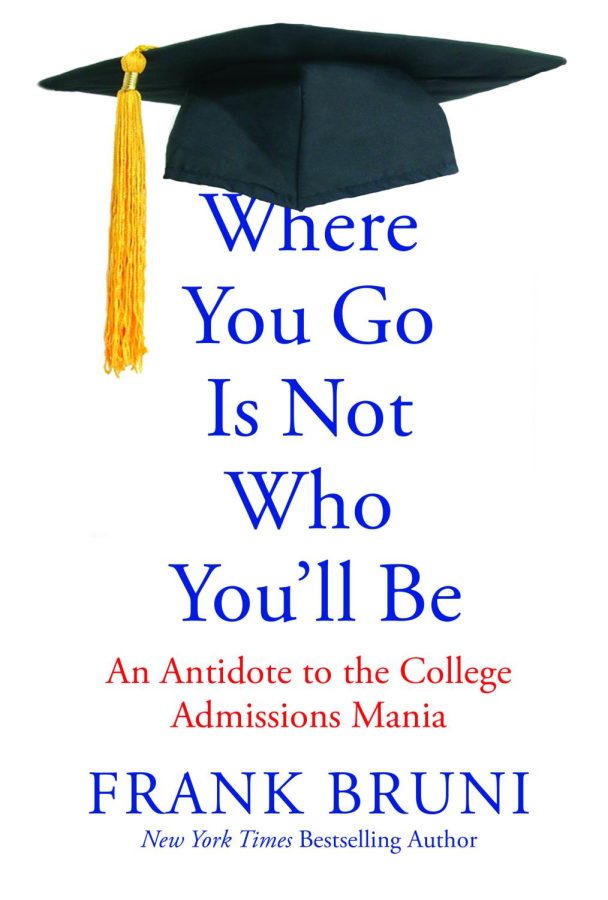the book every high school senior needs to read
“Where You Go Is Not Who You’ll Be”, by Frank Bruni, offers unparalleled insight into the college admissions mania.
This past month, I had the chance to read “Where You Go Is Not Who You’ll Be”. As a senior in high school, I’m no exception to the daunting and overarching umbrella that looms over senior year: college admissions.
I’m fortunate enough to come from a family where a college name isn’t held over my head as some pedestal I must live up to, and I go to a school where I’m given strong guidance in preparing me for my next chapter whatever that may look like. While I’m lucky to have these support networks during a pivotal point in my life, like almost every other senior, this positivity is constantly clouded by societal and peer pressure: the pressure to choose prestige over personal fit, rank over rationale, and impressive over individualized. While some are more affected by this pressure than others, author Frank Bruni aims to break down all the barriers that stand in the way of the college admissions mania being one surrounded by positivity instead of negativity.
One of the most central narratives of this book is the idea that you don’t have to attend a Top 20, Top 50, or whatever the capping number is, to be successful in your post-college life. Highly distinguished figures such as Dick Parsons, a very successful business executive, Ronald Reagan and Jimmy Carter, both U.S. presidents, and Condoleezza Rice, Former United States Secretary of State and current professor at Stanford University, are just a few of these testimonial figures mentioned in the book that all have one thing in common: an untraditional path to success. None of them went to the elite institutions that many people today deem as “successful” or “impressive,” yet they are some of the most accomplished individuals in their professional spheres.
Another important theme in this book is the advantage legacies have in the college admissions process. In the most simple terms, according to Bruni, legacy applicants have a 45.1 percent better chance of getting into the school in question as opposed to a non-legacy applicant. Better yet, if any non-legacy applicant had a 15 percent chance of getting into a school, the legacy applicant had a 60 percent chance of getting into the same school. The legacy advantage becomes even more prevalent as the selectivity of a university increases. For example, a typical Harvard class is composed of 12-13 percent legacy students. In an effort to be transparent, Harvard has acknowledged that the acceptance rate for primary legacies––direct applicant of a parent(s) and grandparent(s)––is around 30 percent, which is close to five times higher than the acceptance rate of the overall applicant pool. The same subset of legacies often overlaps with the small subset of families that can afford access to private tutors, college counselors, and prep schools, all with the hopes of getting their kids on the track to a “highly impressive” college. The fact of the matter, which is no secret, is that money and legacy status, and especially when the two overlap, disproportionately affects and skews the college admissions process into a lofty, unachievable status quo.
While getting a “yes” from a school in the college admissions process is utterly exhilarating, it almost seems like most seniors are more likely to remember a “no,” and allow a “no” to stain their successes. Justin de Benedictis-Kessner, an interviewee of Bruni, arrived at the College of William and Mary without much excitement. He had attended a prestigious prep school that essentially manufactures its students into the most promising and attractive products throughout the years to highly regarded colleges and universities; however, he did not receive admission to his top choice, Swarthmore. After that rejection, he was still left with a handful of high quality options such as Tufts, UCLA, UCSD, the College of William and Mary, and George Washington University, to name a few. Tufts was his next top choice, though due to their inability to present adequate financial aid, regret trailed him on his way to the College of William and Mary, where he did receive gracious financial aid. Throughout his time there, he took advantage of many academic and extracurricular activities, pointing him in the direction of success, not regret.
The redirection that rejection presents is incredibly difficult to see as a senior, but it really can be a pivotal point in someone’s life. Just because your initial plan didn’t work out the way you had hoped, the other directions out there are filled with just as much potential, if not more.
All in all, Bruni compiles such valuable information into a perfect book for high school seniors. From the pedestal of prestige, to the typicality of rejection, to making the financially smart decision, Bruni hits all the factors of the college admissions process that often get lost and ignored during many students’ senior year of high school. If you have the chance to read this book, it truly has the chance to change your perspective on a process that in today’s world remains surrounded by grave toxicity to something far more positive and productive.

















































